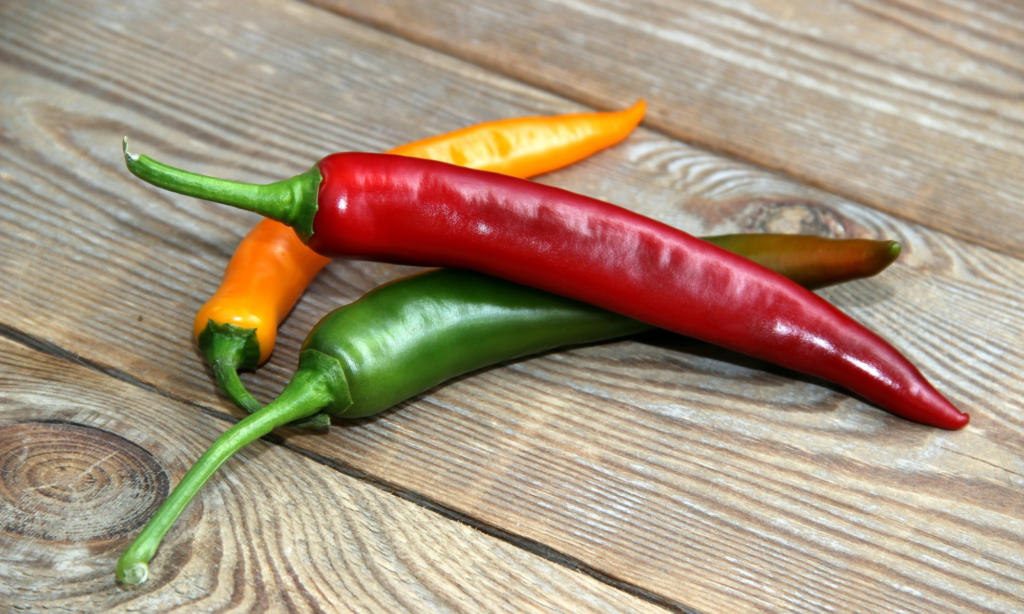
Here in the Netherlands chilli peppers are also called ‘Spanish peppers’. The most well known in the supermarket are the red and green Spanish peppers. But there are more than 30 varieties. The spiciness of the chilli peppers is caused by a component called ‘capsaicin’. In ordinary pepper it is piperine. The amount of capsaicin determines the heat of the chilli peppers which is represented by the so called Scoville Scale.
History
The origin of the chilli pepper is South America. Did you know that pottery dated 7000 BC already depicted chilli peppers? Already at that time they were a valuable taste maker.
Columbus took the chilli pepper to Spain in 1518. There it was called ‘pimiento’ or black pepper. From Spain the chilli pepper started its journey over the world: Europe, Asia and Africa.
(Source: Wikipedia)
The spiciness
The Scoville Scale is used to indicate the heat of the chilli pepper. This scale was developed by William Scoville in 1912. At that time it was determined by an organoleptic (taste) test but today we can measure capsaicin and its derivatives.
To us a dish with an indication of 500-1000 on the Scoville Scale is ‘hot’. But when you think of Sambal Oelek with a score of 2000 and Tabasco 5000 you can imagine that our taste buds need some training.
Contrary to what we think, capsaicin is not present in the seeds. You will find it primarily in the seed membrane and some in the pulp.
On this website you can find a number of articles on the different cultivars that we grow. And there you can also find the individual Scoville values of these chilli pepper varieties.
The plant
Chilli peppers are the berry-fruits of plants of the genus Capsicum which belong to the nightshade family Solanaceae. Together with the bell pepper who belongs to this family. These days we can also find them in garden centers because it is a decorative plant.
We grow the chilli peppers in a hothouse because they like a warm climate. They grow to large plants (4-5 m) and deliver many chilli peppers. The harvest starts at the bottom and we have to climb higher and higher to get to the top.
Is it a vegetable?
From a botanical viewpoint the chilli pepper is a berry, because its purpose is reproduction of the plant. But we, horticulturists, call them fruits. When chilli peppers are still green, we call it a vegetable. And when the red pepper is dried it is called a spice. Confusing, don’t you agree?
Eating chilli peppers
You use chilli peppers to add more spiciness to a dish. Like:
- All kinds of casseroles like chilli con carne, curry’s.
- Sauces like Mexican salsa, chipoltle sauce, sambal, tabasco.
- Marinades for meat and chicken.
- In a stir fry with vegetables.
- Raw in a salad or sliced in a dressing.
- Fry separately and eat as a side dish, green habanero’s for instance.
- In a (vegetable) broth or soup.
There are many ways to spice up a dish with chilli peppers! In the articles section, under the category ‘recipes’ you’ll find our favorite dishes.
Chilli peppers and health
Capsaicin is considered a health improving substance. It is supposed to have anti-inflammatory, antioxidant, anti-cancer and blood sugar regulating properties. It is also considered to be a fat burner. There is a lot of research going on to find out to what extend these health improving properties can be substantiated.
Furthermore, capsaicin is used in cremes for joint aches and it works as an expectorant with colds.
Apart from capsaicin, chilli peppers are rich in antioxidants, flavonoids, vitamin C and A. All nutrients beneficial to our health.
The old Maya’s and Aztecs used chilli pepper for medicinal purposes, with toothaches for instance.
